The Cambridge History of Japan, Vol. 3: Medieval Japan
Подождите немного. Документ загружается.

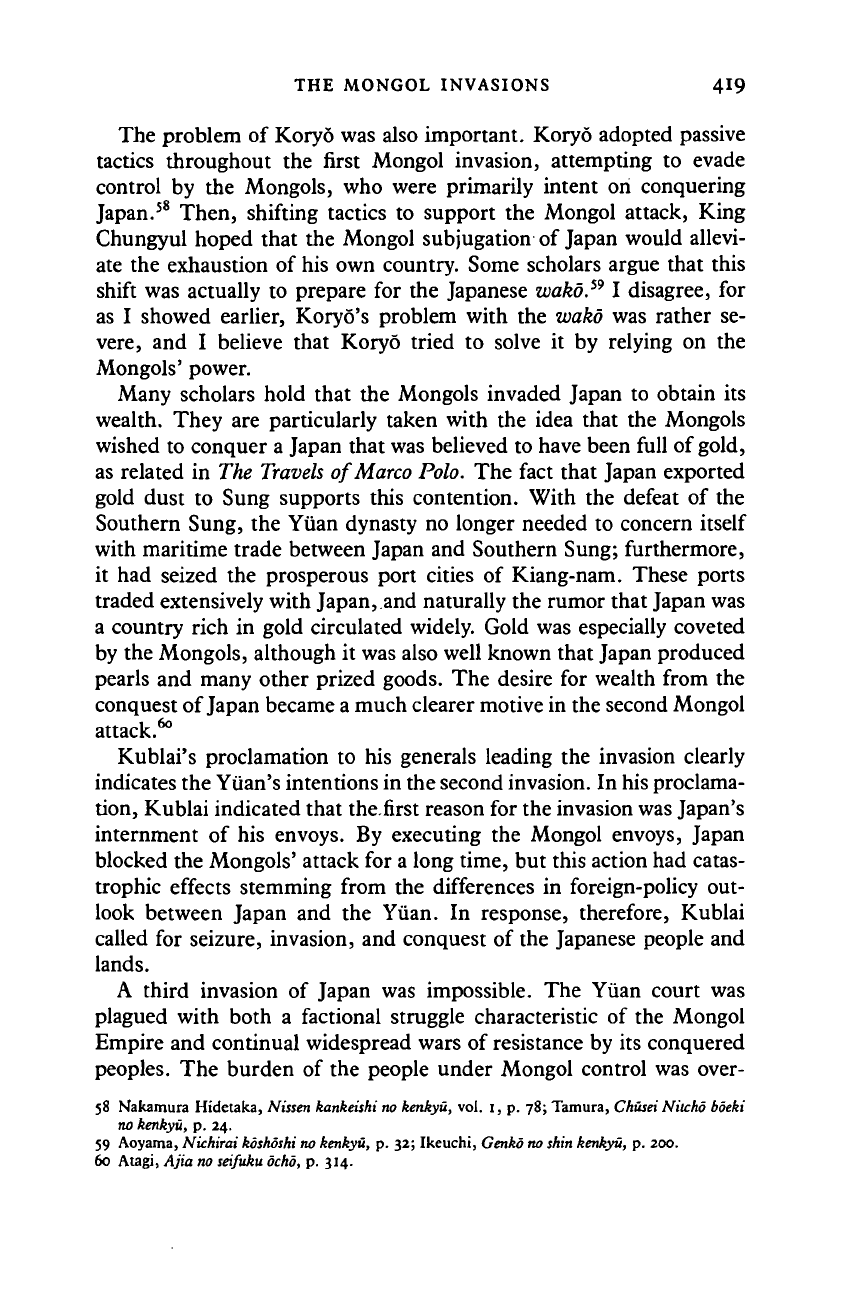
THE MONGOL INVASIONS 419
The problem of Koryo was also important. Koryo adopted passive
tactics throughout the first Mongol invasion, attempting to evade
control by the Mongols, who were primarily intent on conquering
Japan.
58
Then, shifting tactics to support the Mongol attack, King
Chungyul hoped that the Mongol subjugation of Japan would allevi-
ate the exhaustion of his own country. Some scholars argue that this
shift was actually to prepare for the Japanese wako.
59
1 disagree, for
as I showed earlier, Koryo's problem with the wako was rather se-
vere,
and I believe that Koryo tried to solve it by relying on the
Mongols' power.
Many scholars hold that the Mongols invaded Japan to obtain its
wealth. They are particularly taken with the idea that the Mongols
wished to conquer a Japan that was believed to have been full of gold,
as related in The Travels of Marco Polo. The fact that Japan exported
gold dust to Sung supports this contention. With the defeat of the
Southern Sung, the Yuan dynasty no longer needed to concern itself
with maritime trade between Japan and Southern Sung; furthermore,
it had seized the prosperous port cities of Kiang-nam. These ports
traded extensively with Japan, and naturally the rumor that Japan was
a country rich in gold circulated widely. Gold was especially coveted
by the Mongols, although it was also well known that Japan produced
pearls and many other prized goods. The desire for wealth from the
conquest of Japan became a much clearer motive in the second Mongol
attack.
60
Kublai's proclamation to his generals leading the invasion clearly
indicates the Yiian's intentions in the second invasion. In his proclama-
tion, Kublai indicated that the.first reason for the invasion was Japan's
internment of his envoys. By executing the Mongol envoys, Japan
blocked the Mongols' attack for a long time, but this action had catas-
trophic effects stemming from the differences in foreign-policy out-
look between Japan and the Yuan. In response, therefore, Kublai
called for seizure, invasion, and conquest of the Japanese people and
lands.
A third invasion of Japan was impossible. The Yuan court was
plagued with both a factional struggle characteristic of the Mongol
Empire and continual widespread wars of resistance by its conquered
peoples. The burden of the people under Mongol control was over-
58 Nakamura Hidetaka, Nissen kankeishi
no
kenkyu, vol. 1, p. 78; Tamura,
Chusei
Nitcho boeki
no
kenkyu, p. 24.
59 Aoyama, Nichirai
koshoshi no
kenkyu, p. 32; Ikeuchi, Genko
no shin
kenkyu,
p. 200.
60 Atagi, Ajia no
seifuku
ocho,
p. 314.
Cambridge Histories Online © Cambridge University Press, 2008
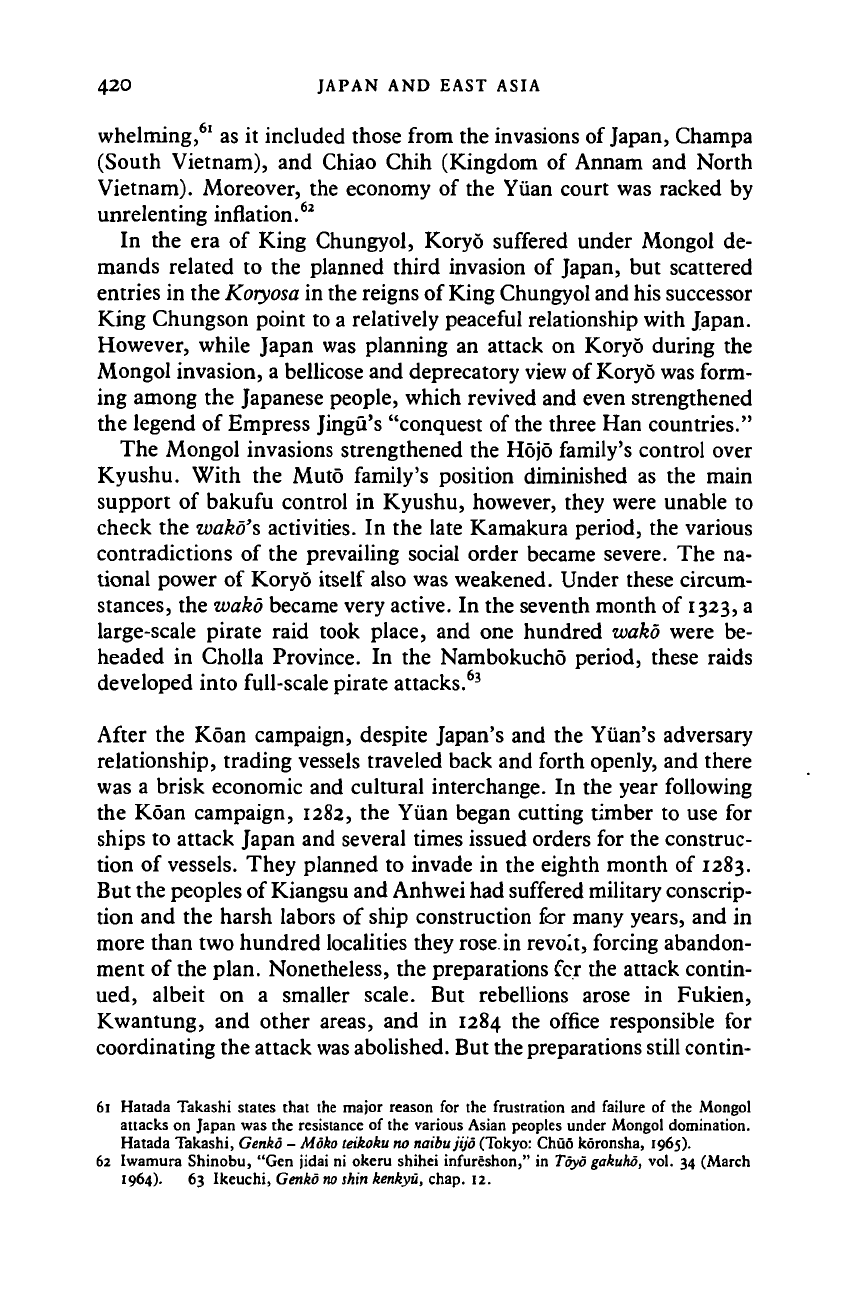
420 JAPAN AND EAST ASIA
whelming,
61
as it included those from the invasions of Japan, Champa
(South Vietnam), and Chiao Chih (Kingdom of Annam and North
Vietnam). Moreover, the economy of the Yuan court was racked by
unrelenting inflation.
62
In the era of King Chungyol, Koryo suffered under Mongol de-
mands related to the planned third invasion of Japan, but scattered
entries in the
Koryosa
in the reigns of King Chungyol and his successor
King Chungson point to a relatively peaceful relationship with Japan.
However, while Japan was planning an attack on Koryo during the
Mongol invasion, a bellicose and deprecatory view of
Koryo
was form-
ing among the Japanese people, which revived and even strengthened
the legend of Empress Jingu's "conquest of the three Han countries."
The Mongol invasions strengthened the Hojo family's control over
Kyushu. With the Muto family's position diminished as the main
support of bakufu control in Kyushu, however, they were unable to
check the wako's activities. In the late Kamakura period, the various
contradictions of the prevailing social order became severe. The na-
tional power of Koryo itself also was weakened. Under these circum-
stances, the wako became very active. In the seventh month of
1323,
a
large-scale pirate raid took place, and one hundred wako were be-
headed in Cholla Province. In the Nambokucho period, these raids
developed into full-scale pirate attacks.
63
After the Koan campaign, despite Japan's and the Yuan's adversary
relationship, trading vessels traveled back and forth openly, and there
was a brisk economic and cultural interchange. In the year following
the Koan campaign, 1282, the Yuan began cutting timber to use for
ships to attack Japan and several times issued orders for the construc-
tion of vessels. They planned to invade in the eighth month of 1283.
But the peoples of Kiangsu and Anhwei had suffered military conscrip-
tion and the harsh labors of ship construction for many years, and in
more than two hundred localities they rose in revolt, forcing abandon-
ment of the plan. Nonetheless, the preparations fcr the attack contin-
ued, albeit on a smaller scale. But rebellions arose in Fukien,
Kwantung, and other areas, and in 1284 the office responsible for
coordinating the attack
was
abolished. But the preparations still contin-
61 Hacada Takashi states that the major reason for the frustration and failure of the Mongol
attacks on Japan was the resistance of the various Asian peoples under Mongol domination.
Hatada Takashi, Genko - Moko teikoku no naibujijo (Tokyo: Chud koronsha, 1965).
62 Iwamura Shinobu, "Gen jidai ni okeru shihei infureshon," in Toyo
gakuho,
vol. 34 (March
1964).
63 Ikeuchi, Genko
no shin
kenkyu, chap. 12.
Cambridge Histories Online © Cambridge University Press, 2008
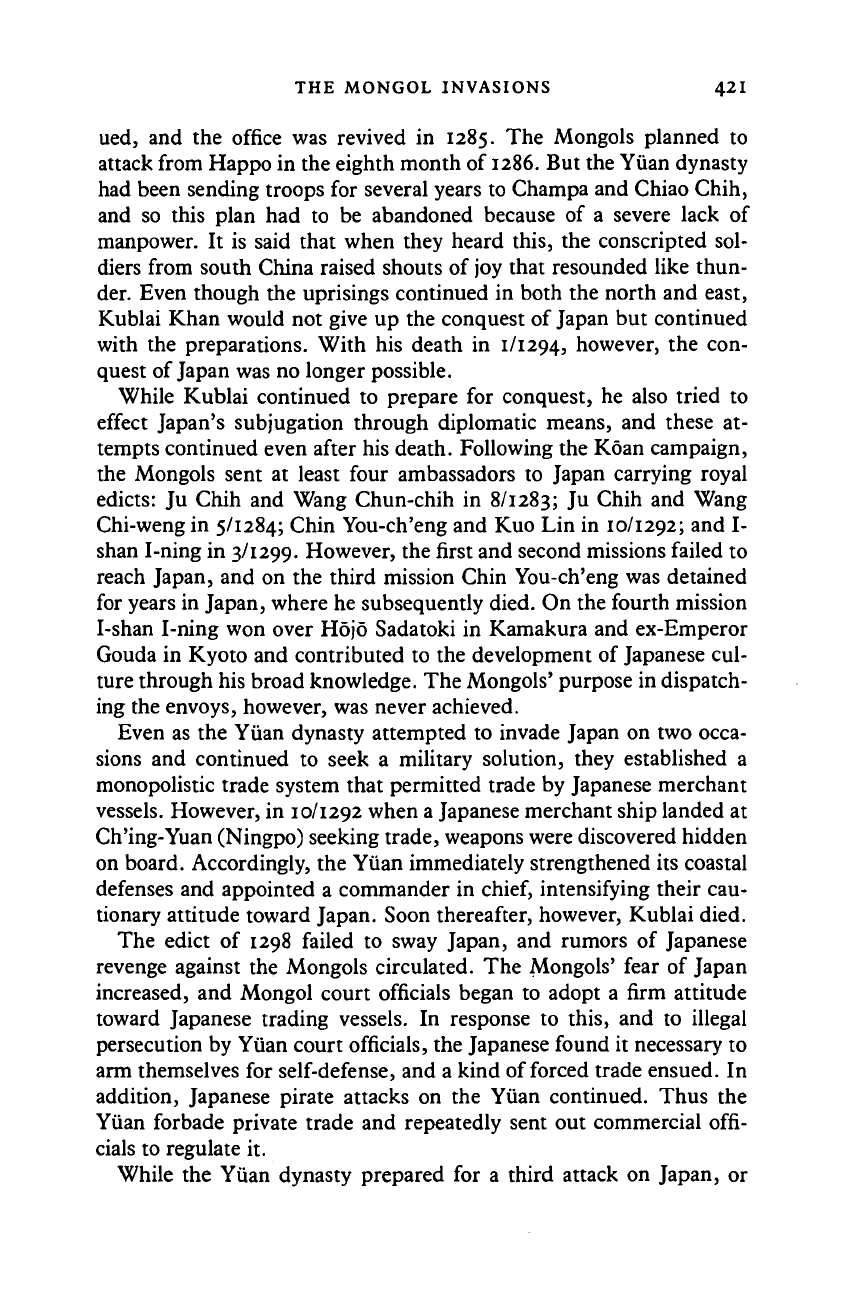
THE MONGOL INVASIONS 421
ued, and the office was revived in 1285. The Mongols planned to
attack from Happo in the eighth month of
1286.
But the Yuan dynasty
had been sending troops for several years to Champa and Chiao Chih,
and so this plan had to be abandoned because of a severe lack of
manpower. It is said that when they heard this, the conscripted sol-
diers from south China raised shouts of joy that resounded like thun-
der. Even though the uprisings continued in both the north and east,
Kublai Khan would not give up the conquest of Japan but continued
with the preparations. With his death in
1/1294,
however, the con-
quest of Japan was no longer possible.
While Kublai continued to prepare for conquest, he also tried to
effect Japan's subjugation through diplomatic means, and these at-
tempts continued even after his death. Following the Koan campaign,
the Mongols sent at least four ambassadors to Japan carrying royal
edicts:
Ju Chih and Wang Chun-chih in 8/1283; Ju Chih and Wang
Chi-weng in 5/1284; Chin You-ch'eng and Kuo Lin in 10/1292; and I-
shan I-ning in 3/1299. However, the first and second missions failed to
reach Japan, and on the third mission Chin You-ch'eng was detained
for years in Japan, where he subsequently died. On the fourth mission
I-shan I-ning won over Hojo Sadatoki in Kamakura and ex-Emperor
Gouda in Kyoto and contributed to the development of Japanese cul-
ture through his broad knowledge. The Mongols' purpose in dispatch-
ing the envoys, however, was never achieved.
Even as the Yuan dynasty attempted to invade Japan on two occa-
sions and continued to seek a military solution, they established a
monopolistic trade system that permitted trade by Japanese merchant
vessels. However, in 10/1292 when
a
Japanese merchant ship landed at
Ch'ing-Yuan (Ningpo) seeking trade, weapons were discovered hidden
on board. Accordingly, the Yuan immediately strengthened its coastal
defenses and appointed a commander in
chief,
intensifying their cau-
tionary attitude toward Japan. Soon thereafter, however, Kublai died.
The edict of 1298 failed to sway Japan, and rumors of Japanese
revenge against the Mongols circulated. The Mongols' fear of Japan
increased, and Mongol court officials began to adopt a firm attitude
toward Japanese trading vessels. In response to this, and to illegal
persecution by Yuan court officials, the Japanese found it necessary to
arm themselves for self-defense, and a kind of forced trade ensued. In
addition, Japanese pirate attacks on the Yuan continued. Thus the
Yuan forbade private trade and repeatedly sent out commercial offi-
cials to regulate it.
While the Yuan dynasty prepared for a third attack on Japan, or
Cambridge Histories Online © Cambridge University Press, 2008
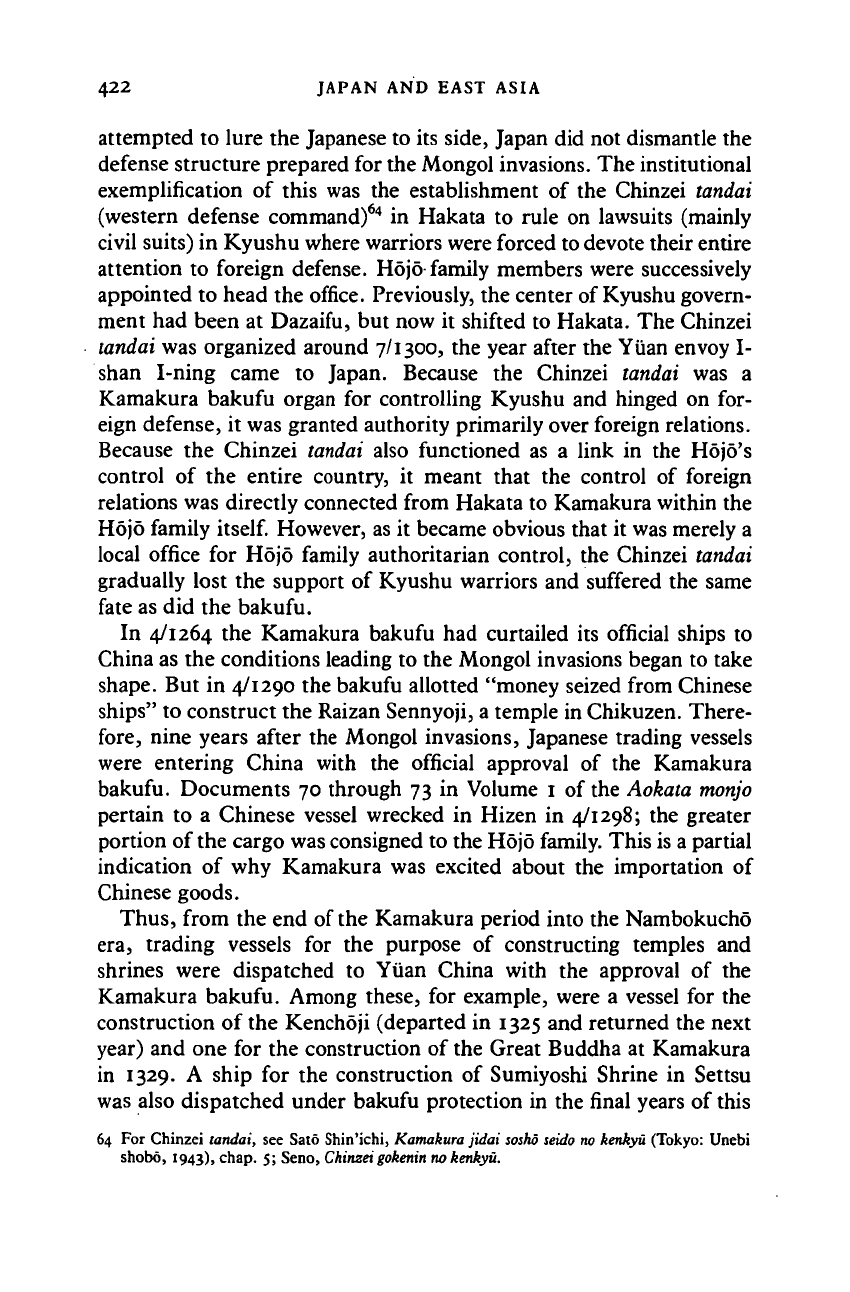
422 JAPAN AND EAST ASIA
attempted to lure the Japanese to its side, Japan did not dismantle the
defense structure prepared for the Mongol invasions. The institutional
exemplification of this was the establishment of the Chinzei tandai
(western defense command)
64
in Hakata to rule on lawsuits (mainly
civil suits) in Kyushu where warriors were forced to devote their entire
attention to foreign defense. Hojo family members were successively
appointed to head the office. Previously, the center of Kyushu govern-
ment had been at Dazaifu, but now it shifted to Hakata. The Chinzei
tandai
was organized around 7/1300, the year after the Yuan envoy I-
shan I-ning came to Japan. Because the Chinzei tandai was a
Kamakura bakufu organ for controlling Kyushu and hinged on for-
eign defense, it was granted authority primarily over foreign relations.
Because the Chinzei tandai also functioned as a link in the Hojo's
control of the entire country, it meant that the control of foreign
relations was directly connected from Hakata to Kamakura within the
Hoj 6 family
itself.
However, as it became obvious that it was merely a
local office for Hojo family authoritarian control, the Chinzei tandai
gradually lost the support of Kyushu warriors and suffered the same
fate as did the bakufu.
In 4/1264 the Kamakura bakufu had curtailed its official ships to
China as the conditions leading to the Mongol invasions began to take
shape. But in 4/1290 the bakufu allotted "money seized from Chinese
ships"
to construct the Raizan Sennyoji, a temple in Chikuzen. There-
fore,
nine years after the Mongol invasions, Japanese trading vessels
were entering China with the official approval of the Kamakura
bakufu. Documents 70 through 73 in Volume 1 of the Aokata
monjo
pertain to a Chinese vessel wrecked in Hizen in 4/1298; the greater
portion of the cargo was consigned to the Hojo family. This is a partial
indication of why Kamakura was excited about the importation of
Chinese goods.
Thus,
from the end of the Kamakura period into the Nambokucho
era, trading vessels for the purpose of constructing temples and
shrines were dispatched to Yuan China with the approval of the
Kamakura bakufu. Among these, for example, were a vessel for the
construction of the Kenchdji (departed in 1325 and returned the next
year) and one for the construction of the Great Buddha at Kamakura
in 1329. A ship for the construction of Sumiyoshi Shrine in Settsu
was also dispatched under bakufu protection in the final years of this
64 For Chinzei tandai, see Sato Shin'ichi, Kamakura jidai
sosho
seido no kenkyu (Tokyo: Unebi
shobo, 1943), chap. 5; Seno, Chinzei
gokenin
no kenkyu.
Cambridge Histories Online © Cambridge University Press, 2008
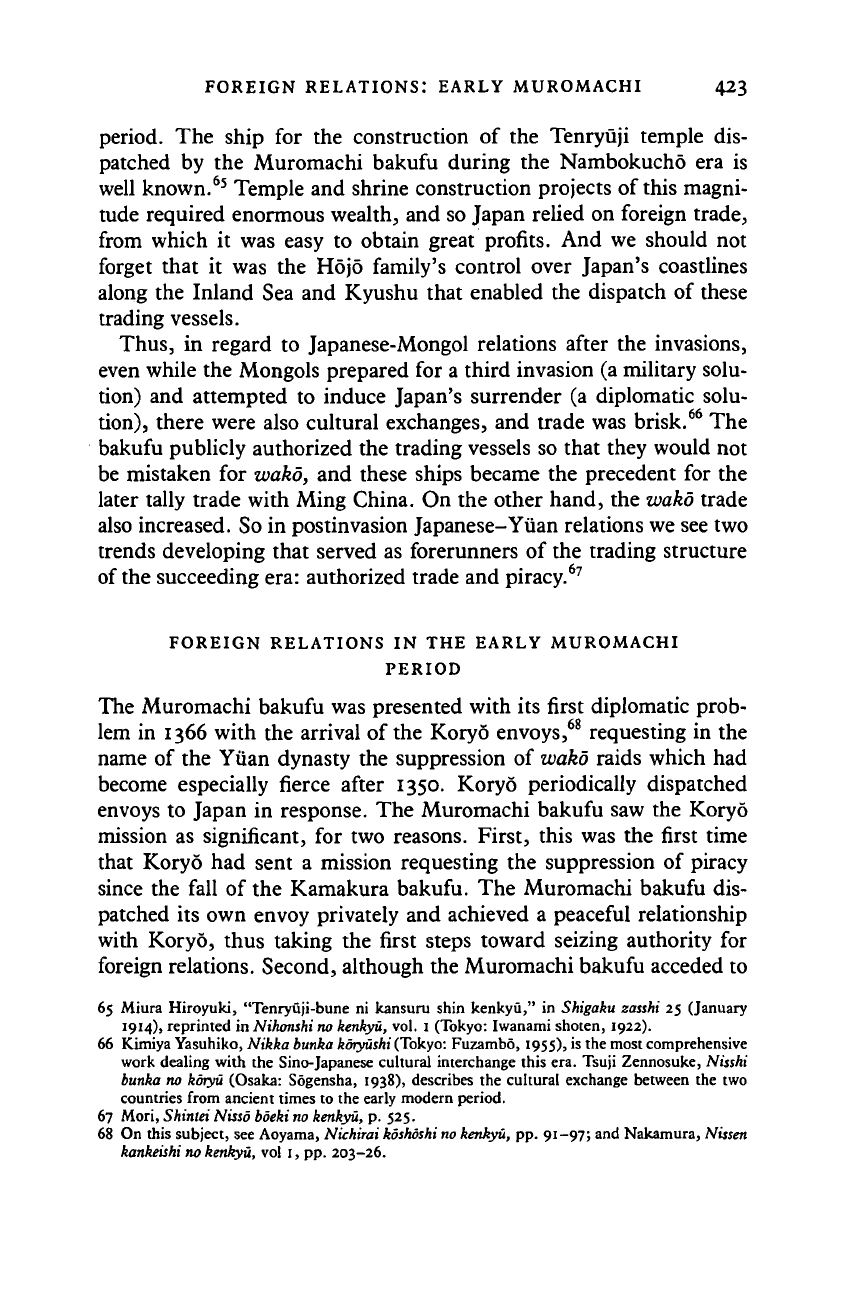
FOREIGN RELATIONS: EARLY MUROMACHI 423
period. The ship for the construction of the Tenryuji temple dis-
patched by the Muromachi bakufu during the Nambokucho era is
well known.
65
Temple and shrine construction projects of this magni-
tude required enormous wealth, and so Japan relied on foreign trade,
from which it was easy to obtain great profits. And we should not
forget that it was the Hojo family's control over Japan's coastlines
along the Inland Sea and Kyushu that enabled the dispatch of these
trading vessels.
Thus,
in regard to Japanese-Mongol relations after the invasions,
even while the Mongols prepared for a third invasion (a military solu-
tion) and attempted to induce Japan's surrender (a diplomatic solu-
tion),
there were also cultural exchanges, and trade was brisk.
66
The
bakufu publicly authorized the trading vessels so that they would not
be mistaken for wako, and these ships became the precedent for the
later tally trade with Ming China. On the other hand, the wako trade
also increased. So in postinvasion Japanese-Yuan relations we see two
trends developing that served as forerunners of the trading structure
of the succeeding era: authorized trade and piracy.
67
FOREIGN RELATIONS IN THE EARLY MUROMACHI
PERIOD
The Muromachi bakufu was presented with its first diplomatic prob-
lem in 1366 with the arrival of the Koryo envoys,
68
requesting in the
name of the Yuan dynasty the suppression of wako raids which had
become especially fierce after 1350. Koryo periodically dispatched
envoys to Japan in response. The Muromachi bakufu saw the Koryo
mission as significant, for two reasons. First, this was the first time
that Koryo had sent a mission requesting the suppression of piracy
since the fall of the Kamakura bakufu. The Muromachi bakufu dis-
patched its own envoy privately and achieved a peaceful relationship
with Koryo, thus taking the first steps toward seizing authority for
foreign relations. Second, although the Muromachi bakufu acceded to
65 Miura Hiroyuki, "Tenryuji-bune ni kansuru shin kenkyu," in Shigaku zasshi 25 (January
1914),
reprinted in Nihonshi no kenkyu, vol. 1 (Tokyo: Iwanami shoten, 1922).
66 Kimiya Yasuhiko, Nikka bunka koryushi (Tokyo: Fuzambo, 1955), is the most comprehensive
work dealing with the Sino-Japanese cultural interchange this era. Tsuji Zennosuke, Nisshi
bunka no koryu (Osaka: Sogensha, 1938), describes the cultural exchange between the two
countries from ancient times to the early modern period.
67 Mori, Shintei Nisso boeki no kenkyu, p. 525.
68 On this subject, see Aoyama, Nichirai
koshoshi
no kenkyu, pp. 91-97; and Nakamura, Nissen
kankeishi no kenkyu, vol 1, pp. 203-26.
Cambridge Histories Online © Cambridge University Press, 2008
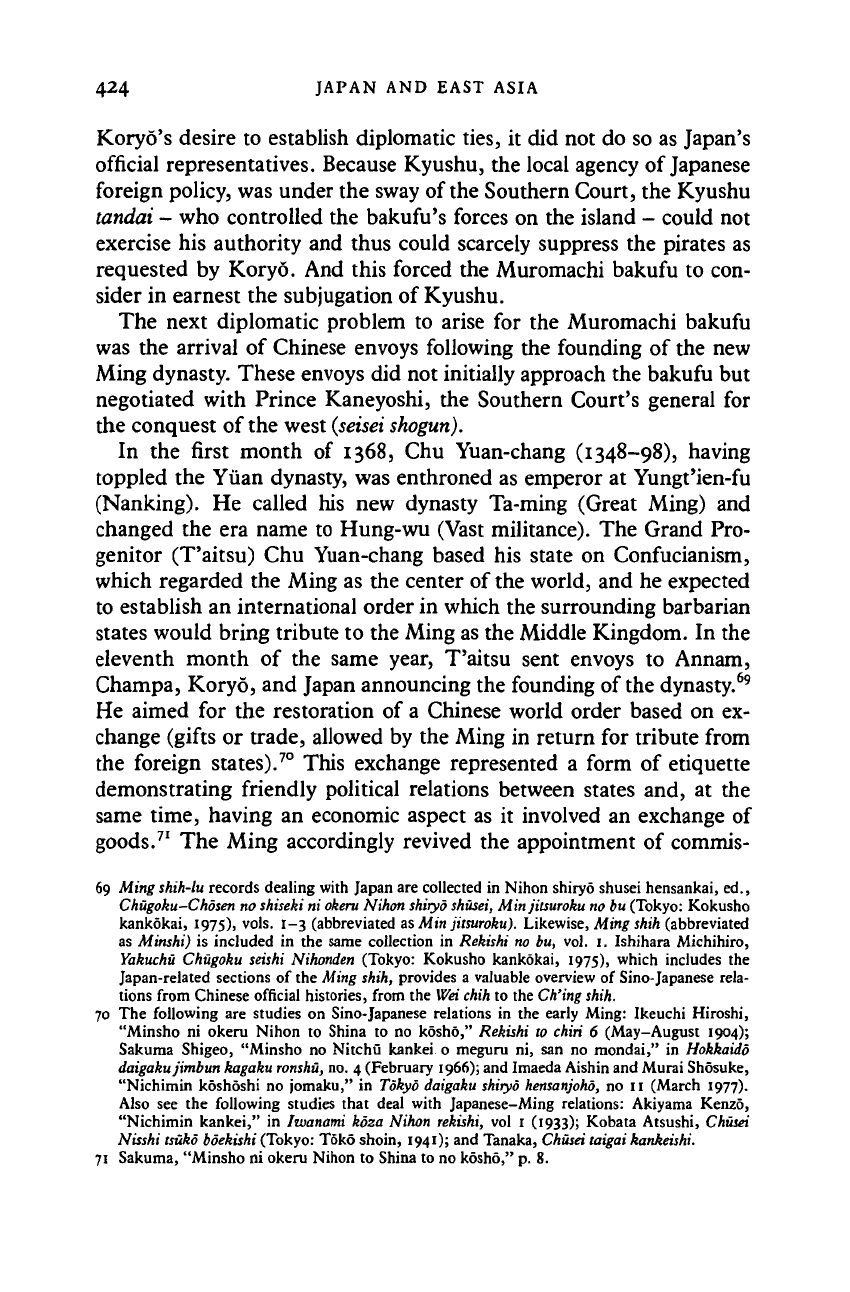
424 JAPAN AND EAST ASIA
Koryo's desire to establish diplomatic ties, it did not do so as Japan's
official representatives. Because Kyushu, the local agency of Japanese
foreign policy, was under the sway of
the
Southern Court, the Kyushu
tandai
- who controlled the bakufu's forces on the island - could not
exercise his authority and thus could scarcely suppress the pirates as
requested by Koryo. And this forced the Muromachi bakufu to con-
sider in earnest the subjugation of Kyushu.
The next diplomatic problem to arise for the Muromachi bakufu
was the arrival of Chinese envoys following the founding of the new
Ming dynasty. These envoys did not initially approach the bakufu but
negotiated with Prince Kaneyoshi, the Southern Court's general for
the conquest of the west
(seisei
shogun).
In the first month of 1368, Chu Yuan-chang (1348-98), having
toppled the Yuan dynasty, was enthroned as emperor at Yungt'ien-fu
(Nanking). He called his new dynasty Ta-ming (Great Ming) and
changed the era name to Hung-wu (Vast militance). The Grand Pro-
genitor (T'aitsu) Chu Yuan-chang based his state on Confucianism,
which regarded the Ming as the center of the world, and he expected
to establish an international order in which the surrounding barbarian
states would bring tribute to the Ming as the Middle Kingdom. In the
eleventh month of the same year, T'aitsu sent envoys to Annam,
Champa, Koryo, and Japan announcing the founding of the dynasty.
69
He aimed for the restoration of a Chinese world order based on ex-
change (gifts or trade, allowed by the Ming in return for tribute from
the foreign states).
70
This exchange represented a form of etiquette
demonstrating friendly political relations between states and, at the
same time, having an economic aspect as it involved an exchange of
goods.
71
The Ming accordingly revived the appointment of commis-
69 Ming shih-lu records dealing with Japan are collected in Nihon shiryo shusei hensankai, ed.,
Chugoku-Chosen no shiseki ni
okeru
Nihon shiryo
shusei,
Minjitsuroku no bu (Tokyo: Kokusho
kankokai, 1975), vols. 1-3 (abbreviated as Min jitsuroku). Likewise, Ming shih (abbreviated
as Minshi) is included in the same collection in Rekishi no bu, vol. 1. Ishihara Michihiro,
Yakuchu Chugoku seishi Nihonden (Tokyo: Kokusho kankokai, 1975), which includes the
Japan-related sections of the Ming shih, provides a valuable overview of Sino-Japanese rela-
tions from Chinese official histories, from the Wei
chih
to the Ch'ing shih.
70 The following are studies on Sino-Japanese relations in the early Ming: Ikeuchi Hiroshi,
"Minsho ni okeru Nihon to Shina to no kosho," Rekishi to chiri 6 (May-August 1904);
Sakuma Shigeo, "Minsho no Nitchu kankei o meguru ni, san no mondai," in Hokkaido
daigakujimbun kagaku ronshu, no. 4 (February 1966); and Imaeda Aishin and Murai Shosuke,
"Nichimin koshoshi no jomaku," in Tokyo daigaku shiryo hensanjoho, no 11 (March 1977).
Also see the following studies that deal with Japanese-Ming relations: Akiyama Kenzo,
"Nichimin kankei," in Izvanami kdza Nihon rekishi, vol 1 (1933); Kobata Atsushi, Chiisei
Nisshi tsuko boekishi (Tokyo: Toko shoin, 1941); and Tanaka, Chiisei taigai kankeishi.
71 Sakuma, "Minsho ni okeru Nihon to Shina to no kosho," p. 8.
Cambridge Histories Online © Cambridge University Press, 2008
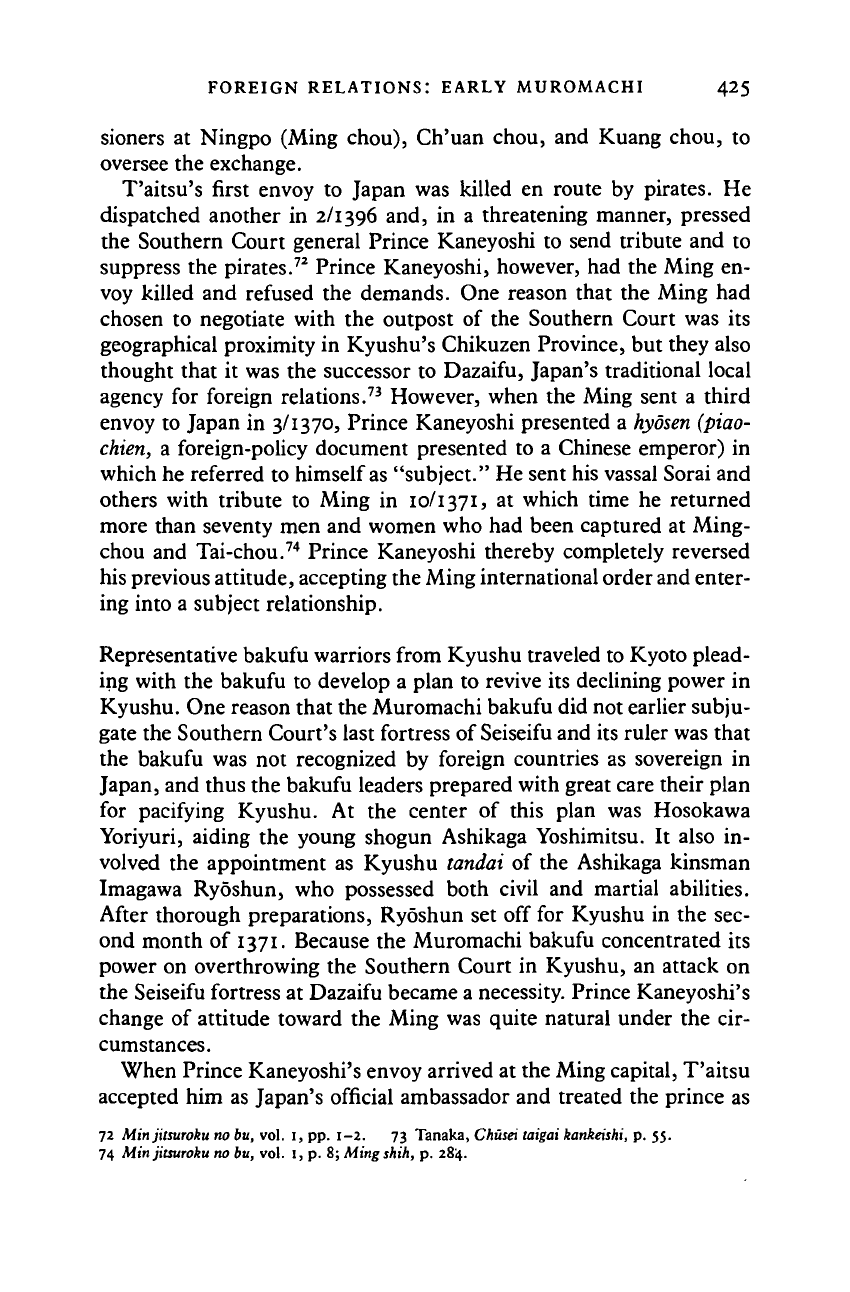
FOREIGN RELATIONS: EARLY MUROMACHI 425
sioners at Ningpo (Ming chou), Ch'uan chou, and Kuang chou, to
oversee the exchange.
T'aitsu's first envoy to Japan was killed en route by pirates. He
dispatched another in 2/1396 and, in a threatening manner, pressed
the Southern Court general Prince Kaneyoshi to send tribute and to
suppress the pirates.
72
Prince Kaneyoshi, however, had the Ming en-
voy killed and refused the demands. One reason that the Ming had
chosen to negotiate with the outpost of the Southern Court was its
geographical proximity in Kyushu's Chikuzen Province, but they also
thought that it was the successor to Dazaifu, Japan's traditional local
agency for foreign relations.
73
However, when the Ming sent a third
envoy to Japan in 3/1370, Prince Kaneyoshi presented a
hydsen
(piao-
chien,
a foreign-policy document presented to a Chinese emperor) in
which he referred to himself
as
"subject." He sent his vassal Sorai and
others with tribute to Ming in
10/1371,
at which time he returned
more than seventy men and women who had been captured at Ming-
chou and Tai-chou.
74
Prince Kaneyoshi thereby completely reversed
his previous attitude, accepting the Ming international order and enter-
ing into a subject relationship.
Representative bakufu warriors from Kyushu traveled to Kyoto plead-
ing with the bakufu to develop a plan to revive its declining power in
Kyushu. One reason that the Muromachi bakufu did not earlier subju-
gate the Southern Court's last fortress of Seiseifu and its ruler was that
the bakufu was not recognized by foreign countries as sovereign in
Japan, and thus the bakufu leaders prepared with great care their plan
for pacifying Kyushu. At the center of this plan was Hosokawa
Yoriyuri, aiding the young shogun Ashikaga Yoshimitsu. It also in-
volved the appointment as Kyushu tandai of the Ashikaga kinsman
Imagawa Ryoshun, who possessed both civil and martial abilities.
After thorough preparations, Ryoshun set off for Kyushu in the sec-
ond month of
1371.
Because the Muromachi bakufu concentrated its
power on overthrowing the Southern Court in Kyushu, an attack on
the Seiseifu fortress at Dazaifu became a necessity. Prince Kaneyoshi's
change of attitude toward the Ming was quite natural under the cir-
cumstances.
When Prince Kaneyoshi's envoy arrived at the Ming capital, T'aitsu
accepted him as Japan's official ambassador and treated the prince as
72 Minjitsuroku no bu, vol. I, pp. 1-2. 73 Tanaka, Chusei laigai
kankeishi,
p. 55.
74 Minjitsuroku no bu, vol. I, p. 8; Ming
shih,
p. 284.
Cambridge Histories Online © Cambridge University Press, 2008
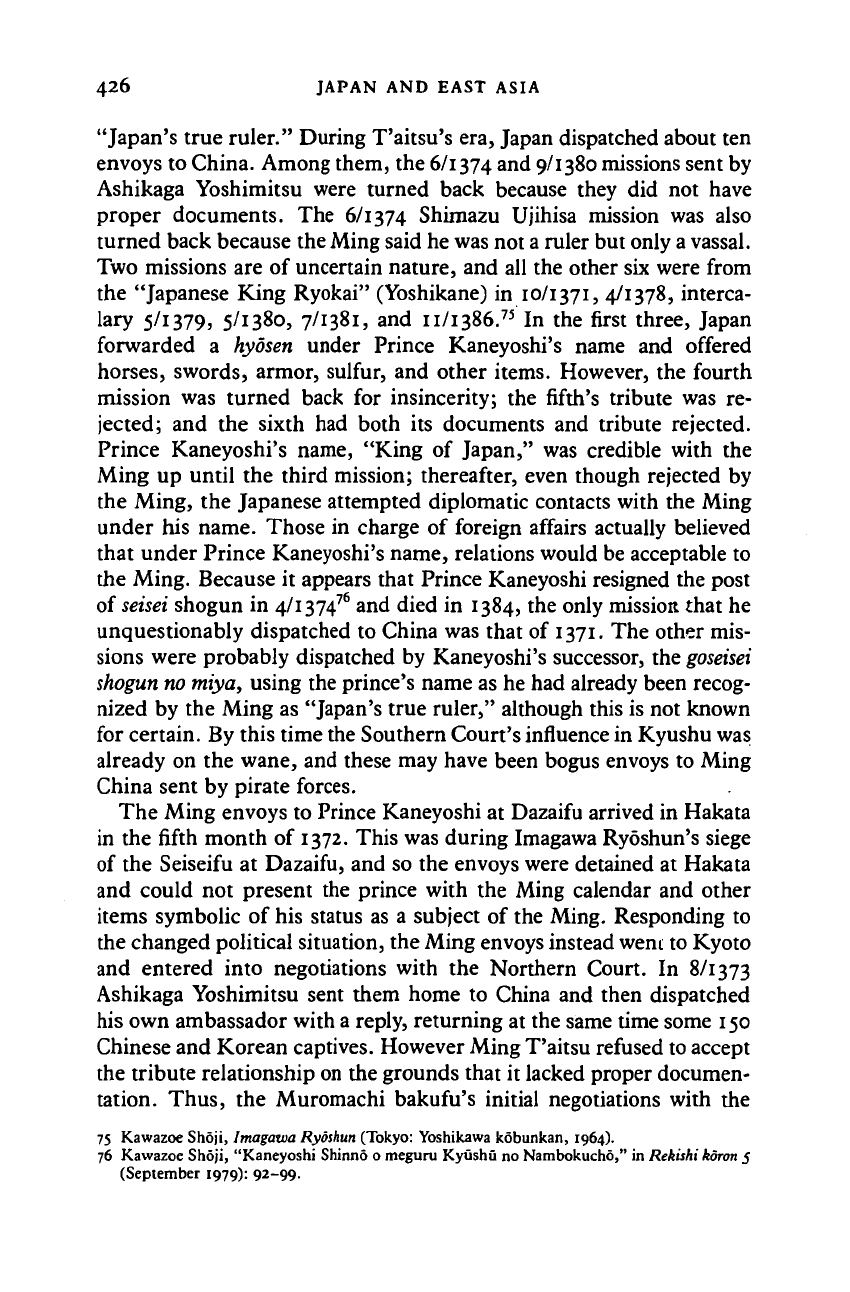
426 JAPAN AND EAST ASIA
"Japan's true ruler." During T'aitsu's era, Japan dispatched about ten
envoys to China. Among them, the 6/1374 and 9/1380 missions sent by
Ashikaga Yoshimitsu were turned back because they did not have
proper documents. The 6/1374 Shimazu Ujihisa mission was also
turned back because the Ming said he was not
a
ruler but only
a
vassal.
Two missions are of uncertain nature, and all the other six were from
the "Japanese King Ryokai" (Yoshikane) in
10/1371,
4/1378, interca-
lary 5/1379, 5/1380, 7/1381, and n/1386.
75
In the first three, Japan
forwarded a hydsen under Prince Kaneyoshi's name and offered
horses, swords, armor, sulfur, and other items. However, the fourth
mission was turned back for insincerity; the fifth's tribute was re-
jected; and the sixth had both its documents and tribute rejected.
Prince Kaneyoshi's name, "King of Japan," was credible with the
Ming up until the third mission; thereafter, even though rejected by
the Ming, the Japanese attempted diplomatic contacts with the Ming
under his name. Those in charge of foreign affairs actually believed
that under Prince Kaneyoshi's name, relations would be acceptable to
the Ming. Because it appears that Prince Kaneyoshi resigned the post
of
seisei
shogun in 4/1374
76
and died in 1384, the only mission that he
unquestionably dispatched to China was that of
1371.
The other mis-
sions were probably dispatched by Kaneyoshi's successor, the
goseisei
shogun
no
tniya,
using the prince's name as he had already been recog-
nized by the Ming as "Japan's true ruler," although this is not known
for certain. By this time the Southern Court's influence in Kyushu was
already on the wane, and these may have been bogus envoys to Ming
China sent by pirate forces.
The Ming envoys to Prince Kaneyoshi at Dazaifu arrived in Hakata
in the fifth month of 1372. This was during Imagawa Ryoshun's siege
of the Seiseifu at Dazaifu, and so the envoys were detained at Hakata
and could not present the prince with the Ming calendar and other
items symbolic of his status as a subject of the Ming. Responding to
the changed political situation, the Ming envoys instead went to Kyoto
and entered into negotiations with the Northern Court. In
8/1373
Ashikaga Yoshimitsu sent them home to China and then dispatched
his own ambassador with a reply, returning at the same time some 150
Chinese and Korean captives. However Ming T'aitsu refused to accept
the tribute relationship on the grounds that it lacked proper documen-
tation. Thus, the Muromachi bakufu's initial negotiations with the
75 Kawazoe Shoji, Imagawa Ryoshun (Tokyo: Yoshikawa kobunkan, 1964).
76 Kawazoe Shoji, "Kaneyoshi Shinno
o
meguru Kyushu
no
Nambokucho,"
in
Rekishi
koron
5
(September 1979): 92-99.
Cambridge Histories Online © Cambridge University Press, 2008
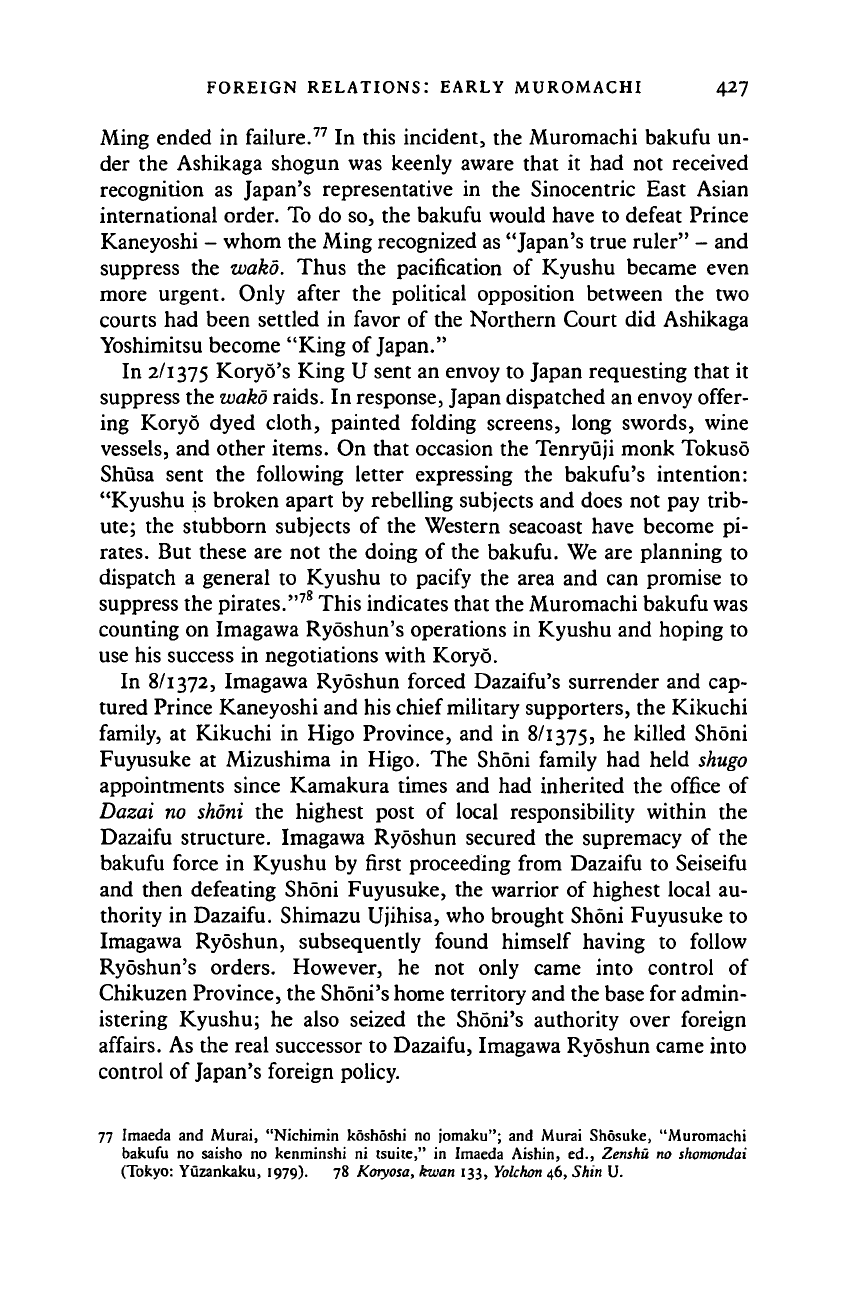
FOREIGN RELATIONS: EARLY MUROMACHI 427
Ming ended in failure.
77
In this incident, the Muromachi bakufu un-
der the Ashikaga shogun was keenly aware that it had not received
recognition as Japan's representative in the Sinocentric East Asian
international order. To do so, the bakufu would have to defeat Prince
Kaneyoshi - whom the Ming recognized as "Japan's
true
ruler" - and
suppress the wako. Thus the pacification of Kyushu became even
more urgent. Only after the political opposition between the two
courts had been settled in favor of the Northern Court did Ashikaga
Yoshimitsu become "King of Japan."
In 2/1375 Koryo's King U sent an envoy to Japan requesting that it
suppress the wako raids. In response, Japan dispatched an envoy offer-
ing Koryo dyed cloth, painted folding screens, long swords, wine
vessels, and other items. On that occasion the Tenryuji monk Tokuso
Shusa sent the following letter expressing the bakufu's intention:
"Kyushu is broken apart by rebelling subjects and does not pay trib-
ute;
the stubborn subjects of the Western seacoast have become pi-
rates.
But these are not the doing of the bakufu. We are planning to
dispatch a general to Kyushu to pacify the area and can promise to
suppress the pirates."
78
This indicates that the Muromachi bakufu was
counting on Imagawa Ryoshun's operations in Kyushu and hoping to
use his success in negotiations with Koryo.
In 8/1372, Imagawa Ryoshun forced Dazaifu's surrender and cap-
tured Prince Kaneyoshi and his chief military supporters, the Kikuchi
family, at Kikuchi in Higo Province, and in 8/1375, he killed Shoni
Fuyusuke at Mizushima in Higo. The Shoni family had held shugo
appointments since Kamakura times and had inherited the office of
Dazai no shoni the highest post of local responsibility within the
Dazaifu structure. Imagawa Ryoshun secured the supremacy of the
bakufu force in Kyushu by first proceeding from Dazaifu to Seiseifu
and then defeating Shoni Fuyusuke, the warrior of highest local au-
thority in Dazaifu. Shimazu Ujihisa, who brought Shoni Fuyusuke to
Imagawa Ryoshun, subsequently found himself having to follow
Ryoshun's orders. However, he not only came into control of
Chikuzen Province, the Shoni's home territory and the base for admin-
istering Kyushu; he also seized the Shoni's authority over foreign
affairs. As the real successor to Dazaifu, Imagawa Ryoshun came into
control of Japan's foreign policy.
77 Imaeda and Murai, "Nichimin koshoshi no jomaku"; and Murai Shosuke, "Muromachi
bakufu no saisho no kenminshi ni tsuite," in Imaeda Aishin, ed., Zenshu no shomondai
(Tokyo: Yuzankaku, 1979). 78 Koryosa, kwan 133,
Yolchon
46, Shin U.
Cambridge Histories Online © Cambridge University Press, 2008
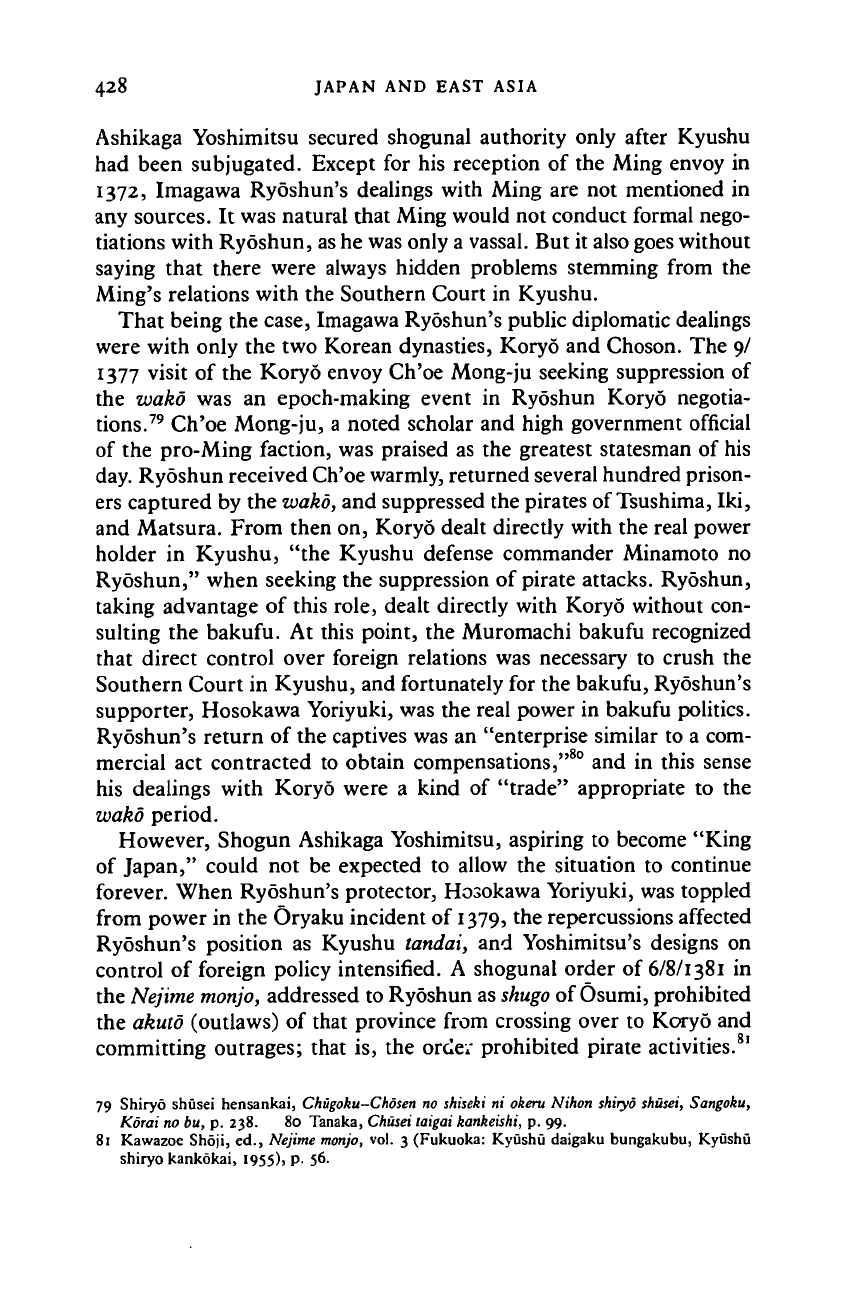
428 JAPAN AND EAST ASIA
Ashikaga Yoshimitsu secured shogunal authority only after Kyushu
had been subjugated. Except for his reception of the Ming envoy in
1372,
Imagawa Ryoshun's dealings with Ming are not mentioned in
any sources. It was natural that Ming would not conduct formal nego-
tiations with Ryoshun,
as
he was only a
vassal.
But it also goes without
saying that there were always hidden problems stemming from the
Ming's relations with the Southern Court in Kyushu.
That being the case, Imagawa Ryoshun's public diplomatic dealings
were with only the two Korean dynasties, Koryo and Choson. The 9/
1377 visit of the Koryo envoy Ch'oe Mong-ju seeking suppression of
the wako was an epoch-making event in Ryoshun Koryo negotia-
tions.
79
Ch'oe Mong-ju, a noted scholar and high government official
of the pro-Ming faction, was praised as the greatest statesman of his
day. Ryoshun received Ch'oe warmly, returned several hundred prison-
ers captured by the
wako,
and suppressed the pirates of Tsushima, Iki,
and Matsura. From then on, Koryo dealt directly with the real power
holder in Kyushu, "the Kyushu defense commander Minamoto no
Ryoshun," when seeking the suppression of pirate attacks. Ryoshun,
taking advantage of this role, dealt directly with Koryo without con-
sulting the bakufu. At this point, the Muromachi bakufu recognized
that direct control over foreign relations was necessary to crush the
Southern Court in Kyushu, and fortunately for the bakufu, Ryoshun's
supporter, Hosokawa Yoriyuki, was the real power in bakufu politics.
Ryoshun's return of the captives was an "enterprise similar to a com-
mercial act contracted to obtain compensations,"
80
and in this sense
his dealings with Koryo were a kind of "trade" appropriate to the
wako period.
However, Shogun Ashikaga Yoshimitsu, aspiring to become "King
of Japan," could not be expected to allow the situation to continue
forever. When Ryoshun's protector, Hosokawa Yoriyuki, was toppled
from power in the Oryaku incident of
1379,
the repercussions affected
Ryoshun's position as Kyushu landai, and Yoshimitsu's designs on
control of foreign policy intensified. A shogunal order of 6/8/1381 in
the
Nejime
monjo,
addressed to Ryoshun as
shugo
of
Osumi,
prohibited
the akuto (outlaws) of that province from crossing over to Koryo and
committing outrages; that is, the order prohibited pirate activities.
81
79 Shiryo shusei hensankai, Chugoku-Chosen no shiseki ni okeru Nihon shiryo shusei, Sangoku,
Korai no bu, p. 238. 80 Tanaka, Chusei laigai kankeishi, p. 99.
81 Kawazoe Shoji, ed., Nejime monjo, vol. 3 (Fukuoka: Kyushu daigaku bungakubu, Kyushu
shiryo kankokai, 1955), p. 56.
Cambridge Histories Online © Cambridge University Press, 2008
